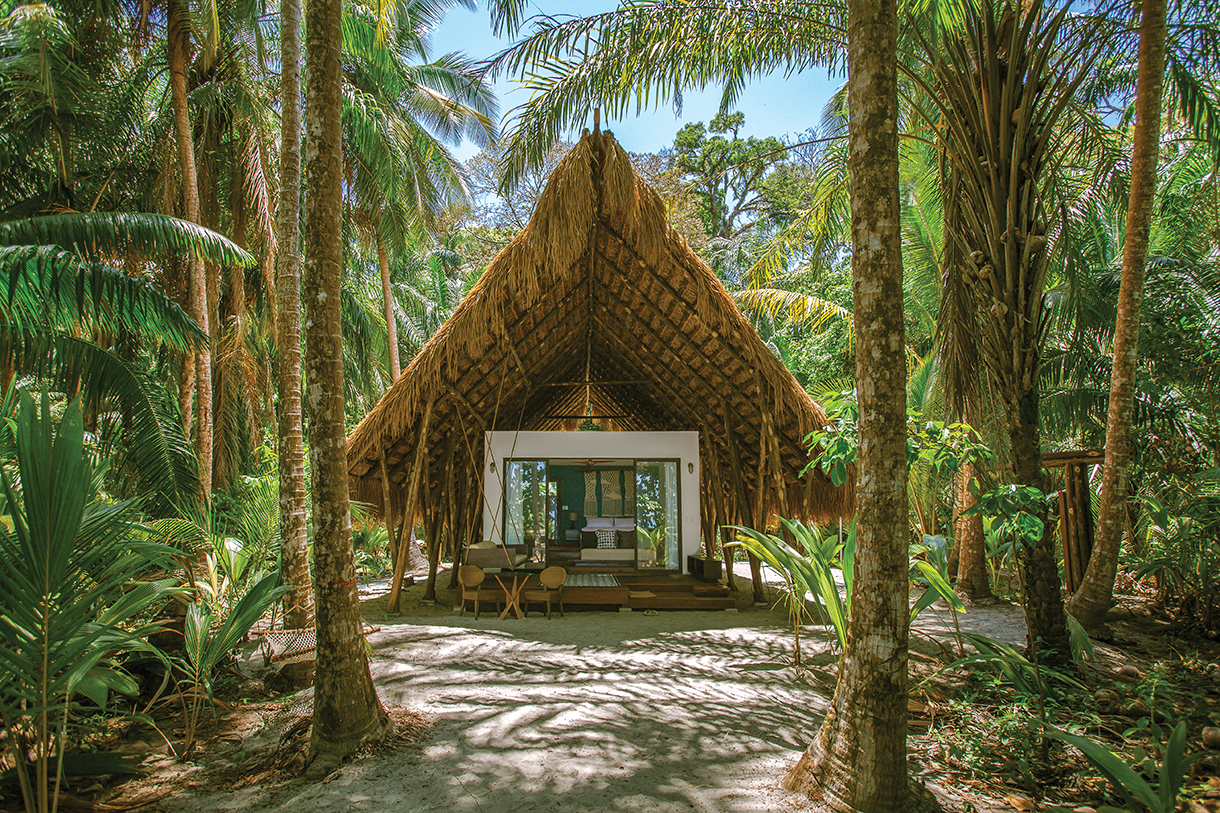
Eco-Warriors
Emerald coastlines, uncharted islands, and biodiverse rainforests in Central America are home to some of Earth’s top experiences in eco-travel. Here, six properties where nature, luxury, and sustainability unite in the best ways possible.

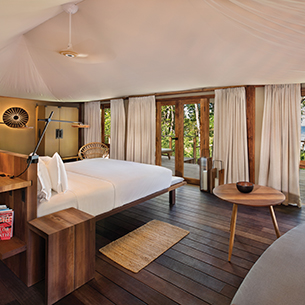
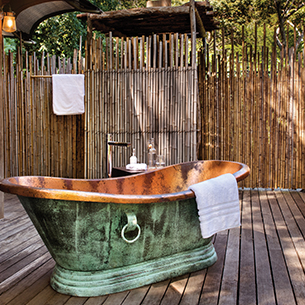
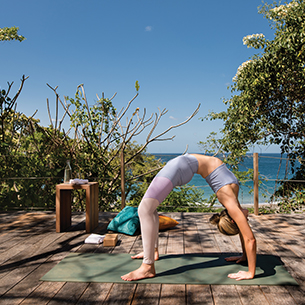
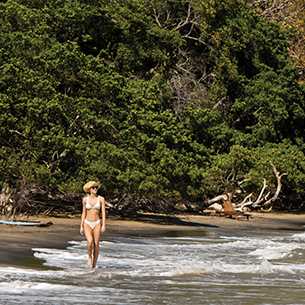
COSTA RICA
KASIIYA PAPAGAYO
Safari-inspired wellness retreat in a dry tropical forest
This “zero-impact,” seven-tented-suite micro-resort inhabits 123 acres of Earth’s last remaining dry tropical forest. Paris-based architecture firm AW2 designed the canvas suites that channel the glamour of an African safari camp, while a trio of white-sand beaches and colossal Guanacaste trees speak to the natural splendor of northwest Costa Rica.
Natural Attractions The Kasiiya experience is one of self-discovery in nature, with an emphasis on mind-body wellness. Active days typically begin and end with outdoor sessions in yoga, meditation, healing, and body movement, set to the symphony of melodic magpie jays and crashing waves. In between, guests go snorkeling, free diving, and hiking with guides; or they can opt to simply lounge on a deserted beach or the terrace of their eco-chic suite (with nary another human in sight).
Sustainable Design Kasiiya’s sustainability mantra begins with a no-impact design. Construction plans were tailored to the topography to avoid sacrificing even a single tree. The resort was then erected over a series of elevated timber frame platforms using screw piles, forgoing the use of any concrete or nails, and employing canvas walls, roofs, and partitions to create distinct spaces. The result: an entire resort that can be dismounted without a trace. What’s more? Kasiiya functions entirely on solar power and all water is sourced from an on-site well. From $800, all-inclusive; kasiiya.com
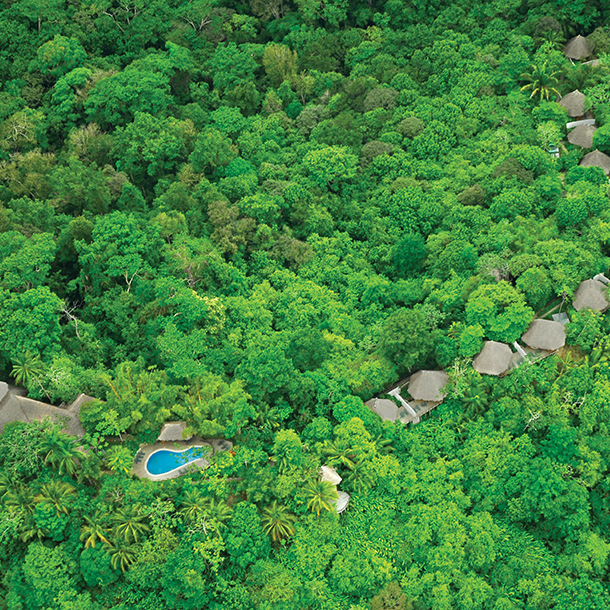
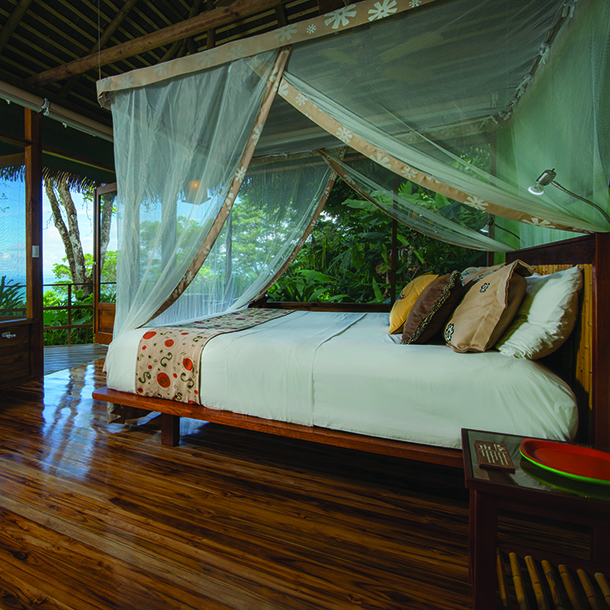
COSTA RICA
LAPA RIOS LODGE
Rainforest rapture for wildlife buffs
Opened in 1993 and a pioneer in eco-travel, Lapa Rios Lodge is a well-known catalyst of Costa Rica’s eco-stardom. Set within a 1,000-acre private reserve that serves as a wildlife corridor to Corcovado National Park—one of the most biodiverse places on Earth—the lodge is bar none for coastal tropical rainforest immersion without having to “rough it.”
Natural Attractions Wildlife enthusiasts can mark off species checklists and score prize-worthy animal photography. Screens replace windows in thatched timber bungalows, ensuring nature’s soundtrack plays at all times. Roaring howler monkeys serve as 5 a.m. wake-up calls to prepare for the day’s excursions, typically on foot and led by in-house guides, biologists, and naturalists. Half- and full-day tours cater to different interests and fitness levels, ranging from miles-long hikes in search of anteaters, sloths, ocelots, and kinkajous to shorter bird-watching expeditions for ogling scarlet macaws and observing rare herons. Truth be told, thanks to an impeccable location, wildlife sightings are equally excellent on property, from the canopy tower frequented by toucans to the al fresco dining area favored by the spider monkeys.
Sustainable Design Original owners John and Karen Lewis had the foresight to purchase 1,000 acres just beyond the 100,000-acre Corcovado National Park in southwest Costa Rica to prevent the clearing of this precious tract and to create a wildlife corridor in an area housing 2.5 percent of the world’s biodiversity. Now permanently protected through a national binding agreement, Lapa Rios Lodge ensures a park buffer zone for generations to come. Each year, the lodge hosts international scientists to study the region’s ecology and gather data to protect Costa Rica’s biological heritage. Decades of exemplary environmental stewardship resulted in the 2017 National Geographic World Legacy Award and the 2018 Tourism for Tomorrow Award. From $1,000, all-inclusive; laparios.com
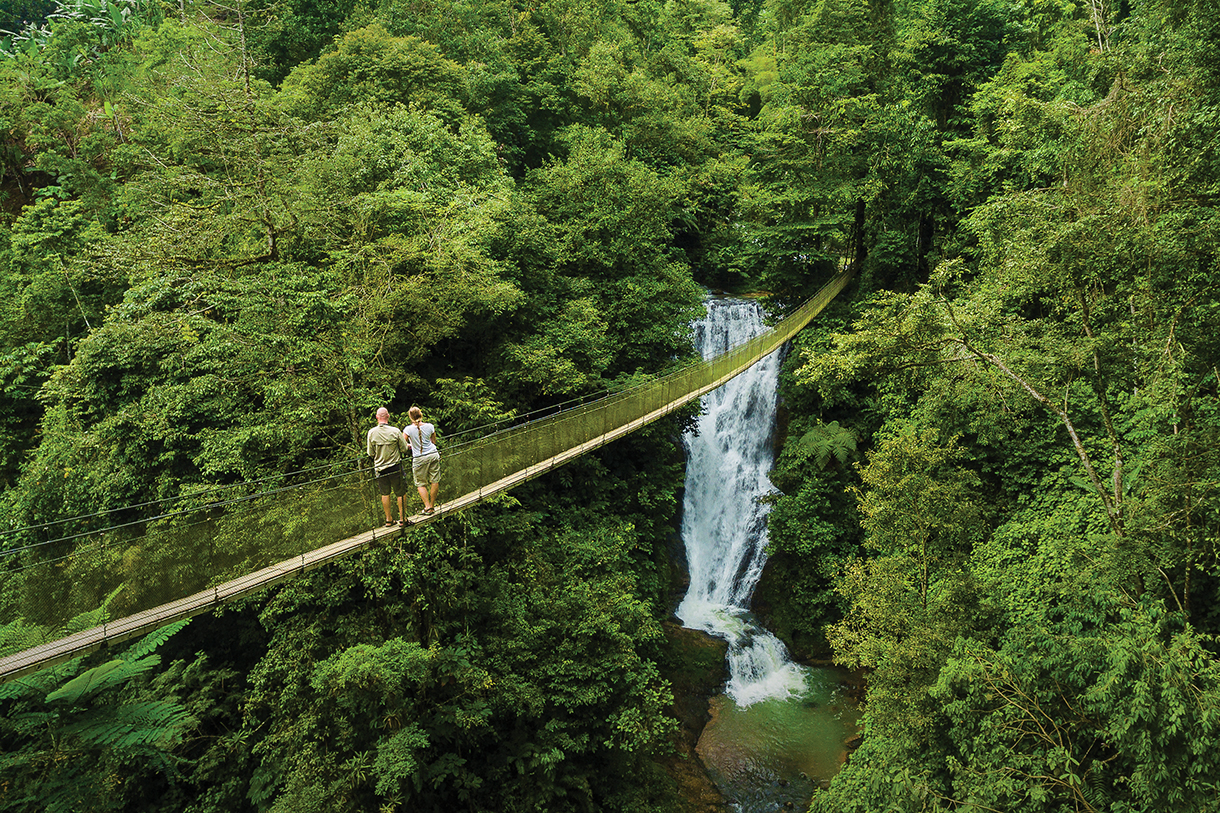
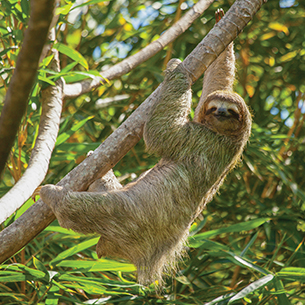
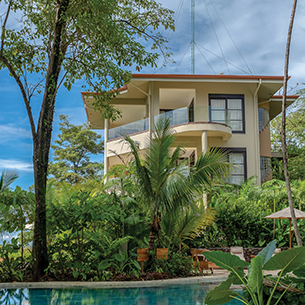
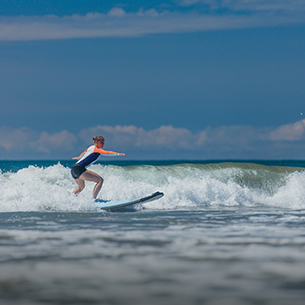
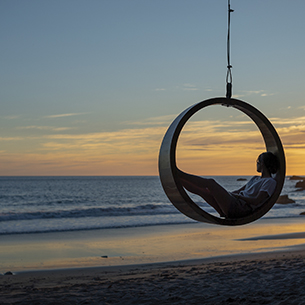
COSTA RICA
ARENAS DEL MAR
Luxe beachfront property with a conscience
Manuel Antonio is one of Costa Rica’s most popular—and developed—beach towns with fragmented jungle that’s home to charismatic creatures like sloths, coatis, and squirrel monkeys. Humans and wildlife regularly interact in and around Arenas del Mar’s high-end, beachfront hotel, dedicated to safeguarding its fragile surroundings.
Natural Attractions In constructing Arenas del Mar, the 11-acre beachfront property was converted from a plantain farm to a private nature reserve and reforested with more than 7,000 native trees and thousands of endemic plants, creating a biological corridor to nearby Manuel Antonio National Park. A complex of larger, concrete buildings, the design skews more resort than eco-lodge and caters to a demographic that enjoys the idea of eco-travel, but isn’t ready to forgo air-conditioning, minibars, private Jacuzzis, and upscale dining. Beyond Arenas del Mar’s duo of full-service beach areas, hundreds of surfers ride the nearby waves, colorful Caribbean-style beach shacks cater to local visitors, and the small but mighty Manuel Antonio National Park almost guarantees that you’ll see a sloth.
Sustainable Design Solar panels provide hot water throughout the property, and during the dry season, the surrounding nature reserve is irrigated using wastewater that is purified on-site. Organic waste is recycled through an advanced, vermiculture-based compost system, and staff regularly participate in beach and trail cleanups through the town and national park. The hotel emphasizes locavore products on its dining menus, offering the likes of sustainably caught seafood from local fishermen and fresh-ground coffee from local roasters. From $375, including breakfast; arenasdelmar.com
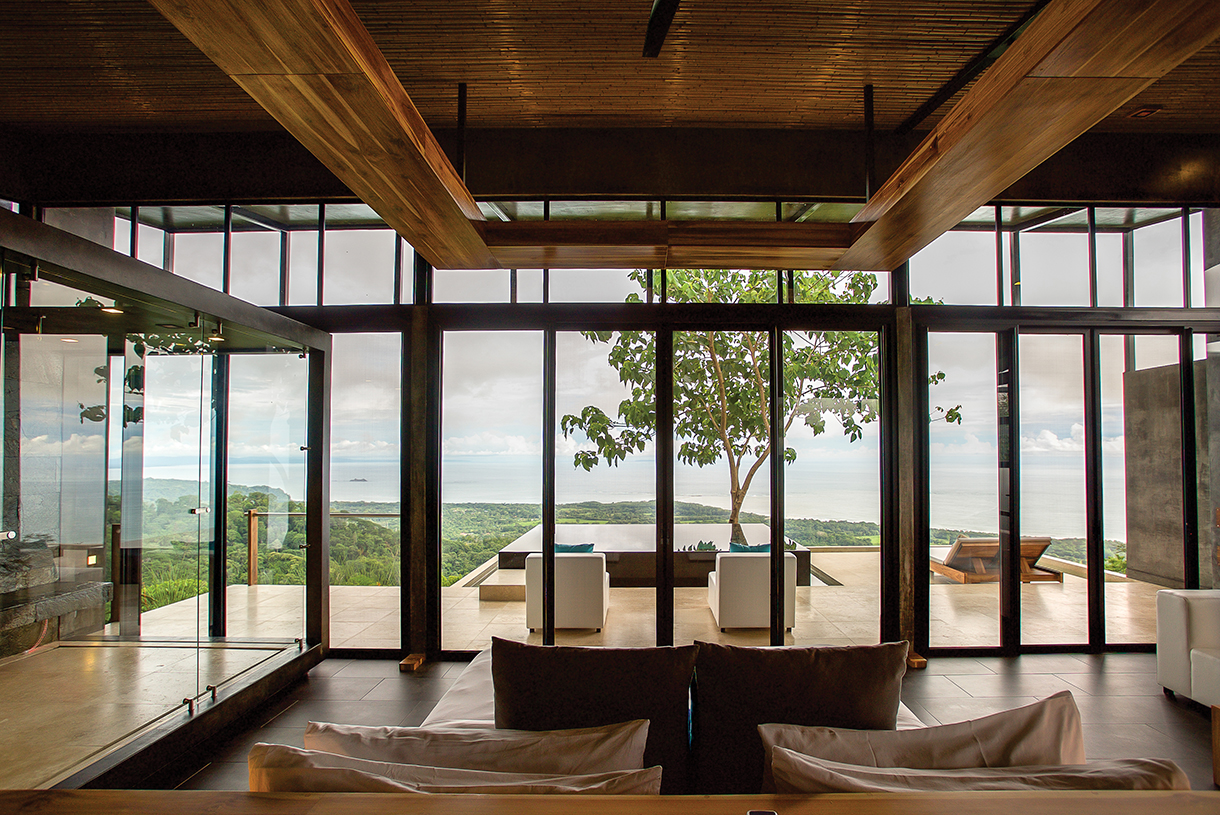
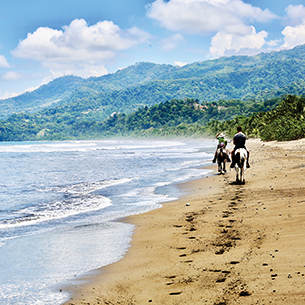
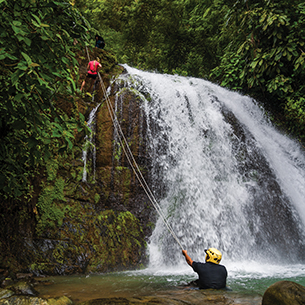
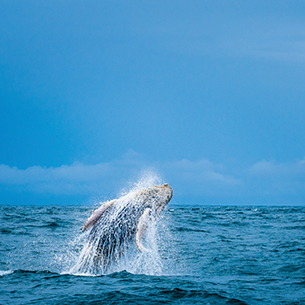
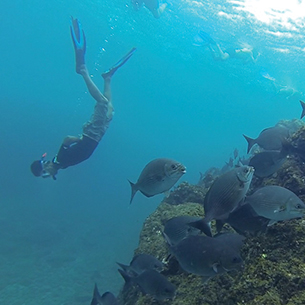
KURA BOUTIQUE HOTEL
The ne plus ultra of jungle chic
Nature and luxury reach new heights in this eight-suite, adults-only property located in the Pacific coastal town of Uvita. Conceived as the passion project of a biologist and an architect, the open-air contemporary build lends to endless panoramas of forest and sea.
Natural Attractions High in the mountainous rainforest near Marino Ballena National Park, Kura delivers the type of bird’s-eye views typically reserved for drone photography. Guest rooms and common areas overlook the country’s iconic Whale’s Tail—a mammoth, natural sand formation in the shape of a whale’s tail, and a lookout from where humpback whales are often sighted. Views of colorful tropical flora interspersed with strata of green foster a sense of hovering above the Earth. Come sunset, the sky erupts in dramatic brushstrokes of purple, pink, and orange. Indoor-outdoor spaces and oversized glass panes ensure the grandeur is constantly in sight, from the shower to the spa. Choose among guided eco-tours—both marine and terrestrial—to nearby reserves and parklands for bird-watching and snorkeling. Many guests opt to never leave Kura’s high-design enticements, watching hummingbirds pass from freestanding hammocks or, drink in hand, from the sleek saltwater infinity-edge pool.
Sustainable Design Making use of natural light and cross ventilation, Kura’s open-air buildings intentionally minimize the need for air-conditioning and lighting fixtures. Previously deforested, the surrounding land is in the process of reforestation. The resort has prioritized investing in the community, providing locals with career paths, buying from local producers, and employing homegrown micro enterprises for tours. To further support environmental education, they finance a curriculum to educate communities on keeping ecosystems healthy and provide assistance to local schools. From $690, including breakfast; kuracostarica.com
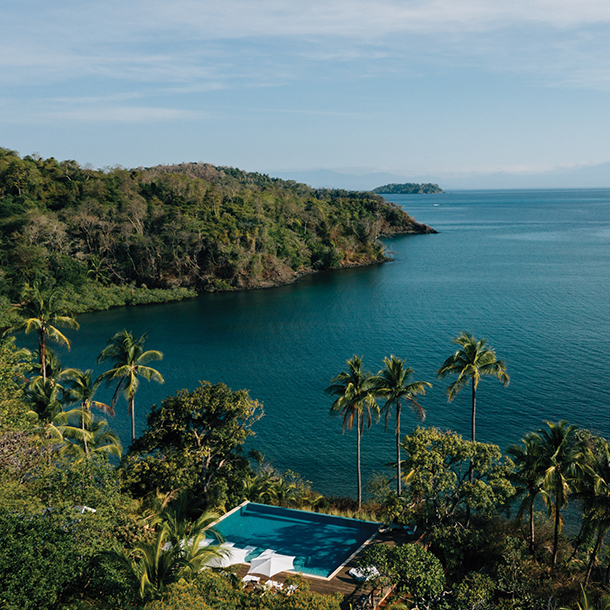
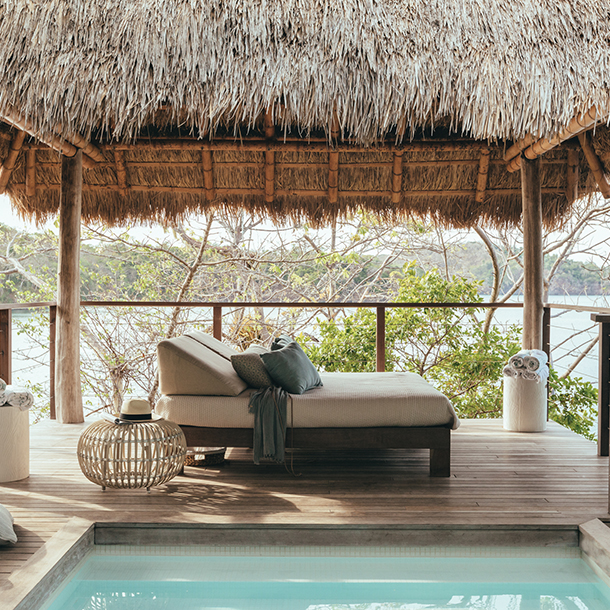
PANAMA
ISLAS SECAS
Exclusive exotica
A new chapter in the world of private-island resorts begins with this secluded multi-island paradise lost within Panama’s Gulf of Chiriquí, 33 miles from the nearest settlement on the country’s Pacific coast. A maximum of 24 guests have exclusive access to 14 islands rimmed in white- and gold-sand beaches. The sapphire waters teem with humpback whales and dolphins. Inland, unspoiled forests thrive with native flora and fauna.
Natural Attractions Low-lying, palm-studded islands contrast with high-rising rocky islets blanketed in dense jungle canopy, all framed by cerulean waters. Over 75 percent of the archipelago has been designated a private nature reserve. Islas Secas’ man-made marvels include seven eco-chic casitas, a design-forward beachfront restaurant, an open-air movie theater, a stargazing lounge, and a hummingbird garden. Harmonizing with nature, all structures artfully incorporate sustainable timber, driftwood, island stones, coral, and shells. Guests do what they want, when they want. Popular choices include island hopping to snorkel among Technicolor tropical reef fish, hiking nature trails rife with pre-Colombian archaeological artifacts, bird-watching, or simply being marooned for a sunset with fresh ceviche and Champagne.
Sustainable Design Thirteen of Islas Secas’ 14 islands remain free of human interference, save for the thousands of native trees replanted to erase degradation of decades past. The single island that is home to all casitas and facilities seeks to minimize impact through sustainably minded operations. In this vain, 100 percent of the property’s energy is solar-generated; 100 percent of wastewater is reclaimed for irrigation; and 100 percent of food waste is converted into fertilizer. From $1,500, all-inclusive; islassecas.com

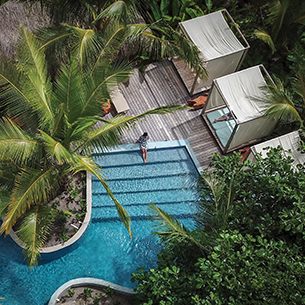

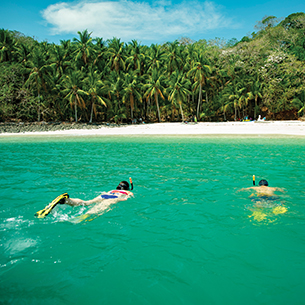
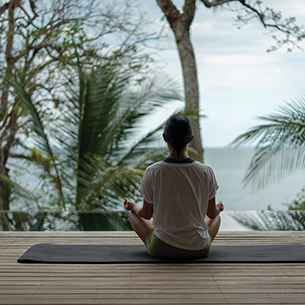
ISLA PALENQUE
Private island perfection
Delivering the apex of tropical, barefoot luxury among its 400 lush acres, this private island retreat opened in 2019 in Panama’s westernmost reaches. Just eight beachfront casitas and one six-bedroom villa access the island’s seven beaches and dense foliage.
Natural Attractions Front porch swings and oversized net hammocks are what jungle dreams are made of. But Isla Palenque promises as much for the active and adventurous as those looking to perfect the art of doing nothing. Half- and full-day activities are updated on the island chalkboard each evening: from guided hikes in search of the island’s nine troops of howler monkeys to snorkeling the coral reefs of neighboring islands to visiting villages and coffee farms around the undiscovered Gulf of Chiriquí.
Sustainable Design The island prides itself on using its resources in nonconventional ways. Most impressive is the use of washed-up driftwood and naturally fallen trees to craft the exquisite furniture found in and around the island. At the on-island woodshop, local carpenters are busy hand-making the likes of dry bars, trail markers, benches, chairs, tables, and armoires. When it comes to Isla Palenque’s food and drink, think fresh: fish from local waters; herbs, fruit, and vegetables from the island’s organic garden; and creative alternatives to single-use products, such as drinking straws made from papaya stems. From $780, all-inclusive; islapalenque.com




